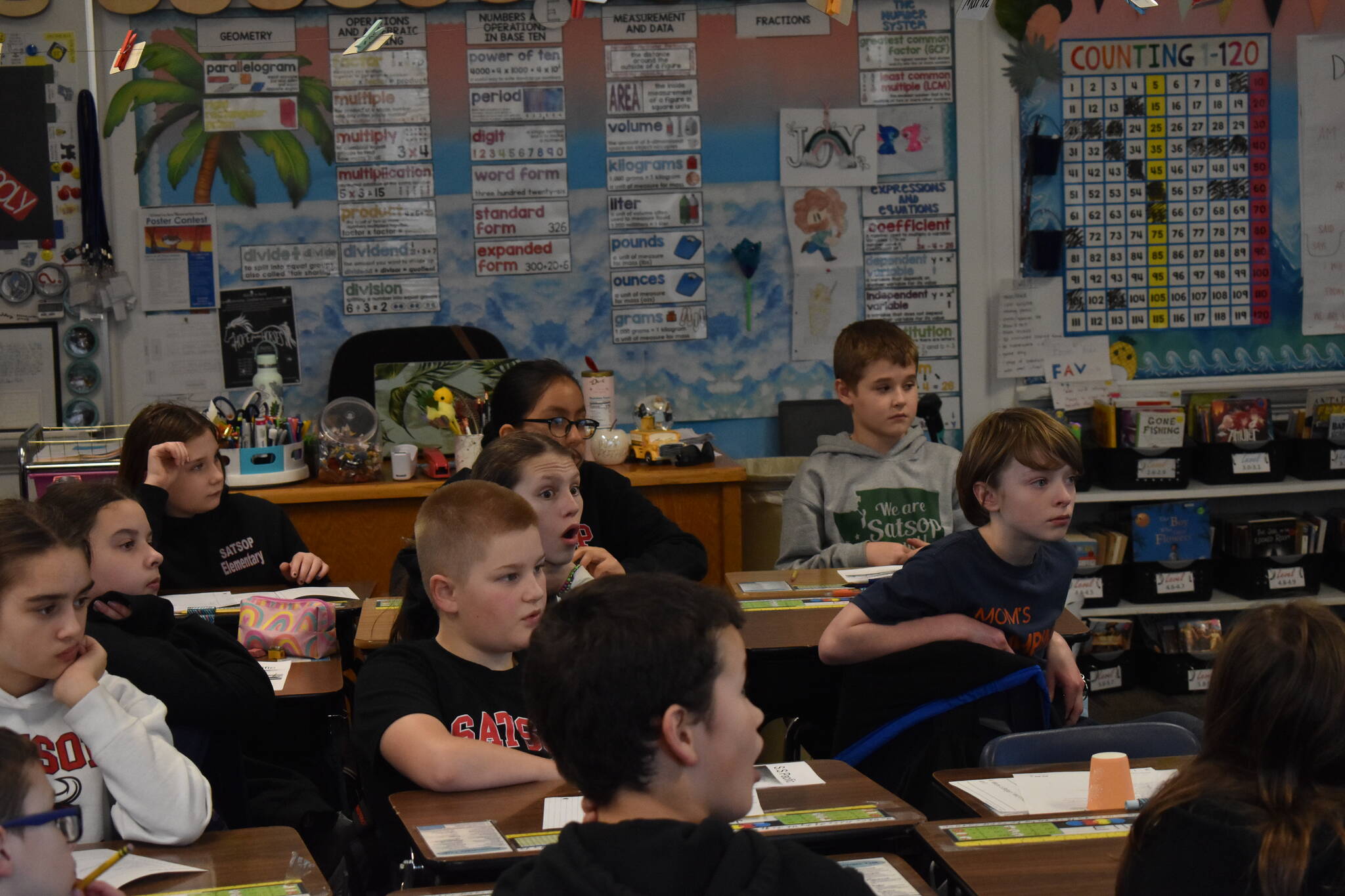Inside a 120-year-old schoolhouse last week, Jeff Hummel slid the plastic case off the homemade robot he recently used to discover a 150-year-old shipwreck, showing the small drone’s wiry intestines.
After years of searching, Hummel and his crew controlled the submersible robot as it dove thousands of feet underwater and grabbed a piece of soggy wood in its claw, delivering the first artifact from a famed shipwreck — the SS Pacific — that could contain millions of dollars of gold.
The discovery became official in December 2022, and Hummel’s company, Rockfish, Inc., now has exclusive rights to salvage artifacts from the ship.
But driving the robot wasn’t the most difficult part of finding the old ship; in fact, Hummel told Sarah Protheroe’s class of 4th, 5th and 6th graders at Satsop Elementary, manipulating the drone was as simple as using a video game controller.
“I was like ‘I could actually do that, I could actually learn to drive these robots around in the water,’” said 5th-grader Josiah Williams after Hummel’s presentation to the class.
Hummel, president of Rockfish, Inc. and director of the Northwest Shipwreck Alliance, visited the school on Friday, Feb. 10 to give students a firsthand look at the robot, nicknamed Falkor, and tell students about the science and history behind the wreck, as well as the effort to find it.
When Protheroe learned about the discovery, she read a newspaper article about it to the class. She reached out to Hummel about presenting to students shortly after. While students thought they would be talking with Hummel virtually, they were surprised when Hummel rolled Falkor on a cart through the schoolhouse door.
“I was like, ‘what, so this famous person is actually coming to this little farm house school?’” Williams said, talking about his reaction to seeing Hummel.
The foundation of ideas he used to find the SS Pacific, Hummel said, he learned in primary education. In third grade, Hummel learned about shipwrecks in class. When he was in seventh grade, Hummel saw Star Wars, and wanted to build a robot of his own.
“A lot of the things you are learning right now are the things you use in the rest of your life,” Hummel told the class. “I learned things when I was in 7th grade that I used every single day while working on this project.”
In ninth grade, Hummel learned mechanics while working in the machine shop for an aeronautical company. At a later job he would learn how to build robots. Much of his Falkor robot, barring the thrusters, was built by hand.
“You could kind of tell it was handmade because you could see all the wires in a couple places,” fourth-grader Elley Osgood said after the presentation. “It was pretty cool.”
Students were also eager to learn more about the lost, and recently found, vessel.
“This group is always really fascinated with pretty much any part of history,” Protheroe said.
The SS Pacific sank Nov. 4, 1875, when it collided with another vessel, the Orpheus, which had taken a misguided turn. The shipwreck was one of the deadliest of the time — newspapers reported 300 dead, but Hummel found other accounts stating 400 or 500 people were on board when it sank. Two people survived.
The 225-foot vessel was carrying gold from the British Columbia gold rush to San Francisco.
Hummel first learned about the SS Pacific when he was in college. He was researching a sunken WWII plane he and his friend, Matthew McCauley, pulled up from the bed of Lake Washington. The U.S. Navy would claim it owned the plane in a lawsuit against Hummel and McCauley, but courts sided with the explorers. The plane has been restored and should be able to fly within the next year or so, Hummel said.
That was 40 years ago, and the SS Pacific, among other projects and occupations, has been on Hummel’s mind since then. He spent more time scouring newspaper archives and historical documents for information on the ship than he did building the robot that would find it. He found out the course of the ship, how fast it was moving at the time of the wreck, and what the tidal currents were. Astoria, Oregon, Hummel said, has the world’s largest archive of tidal currents.
It also took 20 expeditions to locate the vessel, Hummel said.
The shipwreck is remarkably well preserved, Hummel said. Along with the potential for sunken treasure, Hummel believes the shipwreck will contain a curious combination of artifacts: leather boots, clothes, preserved food, and possibly one of the world’s first pairs of Levi’s jeans.
Artifacts will be pulled up from the wreck over the next several years, Hummel said. To house those artifacts, among others, Hummel hopes to start a shipwreck museum in Seattle, where students from Satsop might be able to visit.
”You are a part of this living history now,” Protheroe told her students after the presentation. “You can think to yourself, ‘When I was in fourth, fifth or sixth grade, not only did I watch this on the news or read this in the paper, I experienced it.’”
After the presentation, Zac Werdahl, a 6th-grader, seemed to grasp the historical weight of the situation he was in.
“This is a very important event that we will probably remember for many years,” Werdahl said.
Contact reporter Clayton Franke at 406-552-3917 or clayton.franke@thedailyworld.com.


